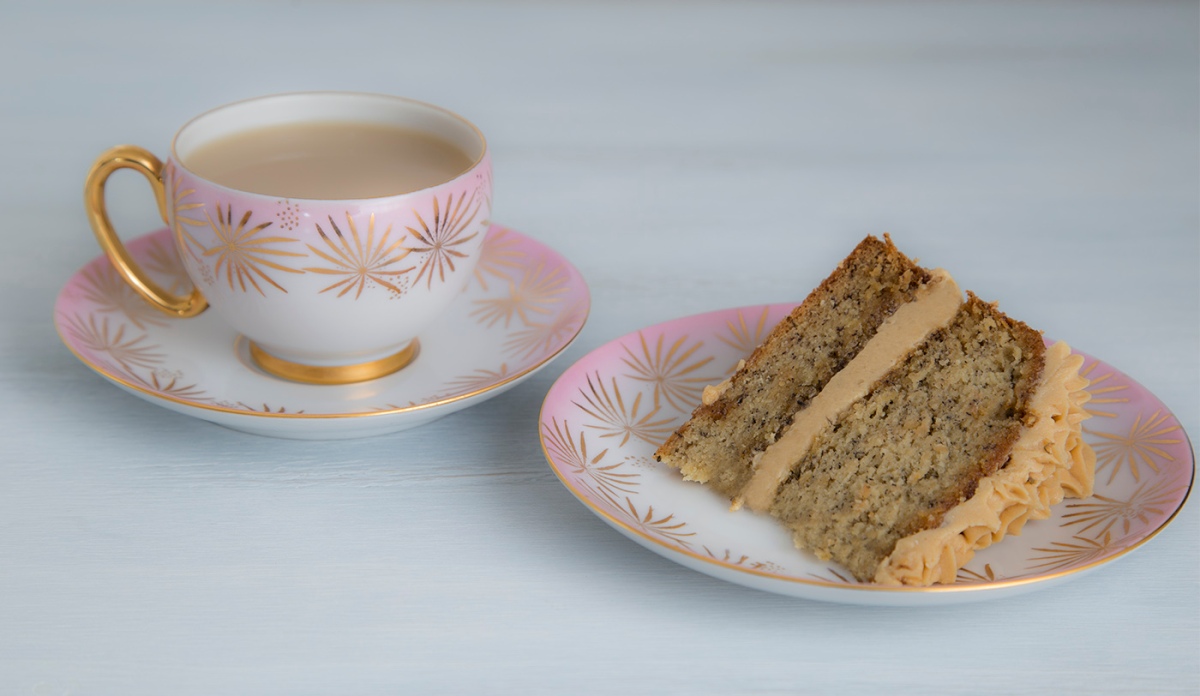
Cup of tea and a slice of cake? Image: Su Leslie 2021
Wherever you are, and whatever is happening in your world, Kia ora koutou katoa (Greetings. Hello to you all)
After our recent see-sawing in and out of lock-down I’ve been feeling the need for a wee celebration cake. And in our household, that means banana cake with (lashings of) coffee buttercream.

Banana cake with coffee buttercream icing. Image: Su Leslie 2021
Do you have a go-to cake (or other sweet treat) that’s your family favourite? What is the story behind it? How does a particular cake cake come to take on the mantle of “celebration”?
In my case, I have my late mother in law, Joy, to thank. My mother didn’t bake banana cake, so my early memories of it are from cake stalls and “ladies a plate” events (see below).
Joy made banana cake for the Big T’s birthdays, and then later for mine. They were unfailingly moist and tasty, had a generous, but not overwhelming, application of coffee-flavoured buttercream, and were often decorated with walnut halves.

First attempt at candied walnuts to top the cake. Image: Su Leslie 2021
For me this is the perfect banana cake, and I’ve never understood why other people’s versions seemed to be coated with anemic and thoroughly unappetizing chocolate icing.
Until last week.
I always bake banana cake from the recipe in the Edmonds Cookery Book — something of a cooking bible in NZ. What I had never noticed before is the last line of the recipe — “When cold ice with Lemon or Chocolate Icing or dust with icing sugar.”
Well, as you can imagine that got me thinking (and quizzing T) about his mother’s coffee buttercream, and about the history of banana cake generally.
Is banana cake a “thing” where you live? If so, what sort of cake is it. Is it iced? Coffee buttercream???
Sorry to bombard you with questions; I really want to know.
My banana cake is basically a butter cake with mashed bananas folded into the mixture. Practically all banana cake recipes in New Zealand are variations on this, and have been for many years. However, one local recipe — from (the delightfully named) Bush Advocate in 1906 — included currents and coconut, while one published in Britain’s Daily Mail published a recipe in 1928, was more of a sponge. In several early recipes from both Australia and New Zealand the banana component is basically sliced banana between layers of cake.
What’s really amazed me about this is a) how old some of the recipes are (1891 in both New Zealand and Australia); and b) how often NZ newspapers printed recipes for banana cake: 136 times between 1891 and 1950, which is the last year for which newspapers are available online through Papers Past.

Image: Su Leslie 2021
But enough of my Musa musings. Pull up a chair, grab a plate and help yourself to some cake.
Tell me what you’ve been up to? What’s happening in your world? Your comments make blogging so much more interesting.
And if you’d like to contribute a post of your own — even better. Maybe a shot of your cuppa and/or whatever you’re having with it. A recipe if you like.
I’ll update each of my posts with a ping-back to everyone’s in the same way as I do with The Changing Seasons.
#virtualteaparty2021 for anyone on Instagram who wants to post images (or video?)
The term “ladies a plate” was ubiquitous in New Zealand when I was growing up, and referred to the convention that catering for social gatherings involved all of the women bringing food. As a new immigrant to this country, my mother suffered the embarrassment of arriving at her first such gathering carrying — literally — a plate, having assumed that the hosts must be short of crockery.
Update
My lovely co-host Del from CurlsNSkirls has baked soda bread, in honour of St Patrick’s Day. You can find her recipe here.
Pop over to see Margaret at Pyrenees to Pennines for a slice of lemon drizzle cake and a cashew nut butter cookie.
Irene at My Slice of Mexico has baked banana bread and shared her recipe. Please check it out.
Have some chicken pasta salad with Ladyleemanila.
Carrot cake is particularly popular, and Ju-Lyn from Touring My Backyard has not only made one (and posted the recipe), but shares a new perspective on what “carrot cake” means in Singapore.
Deb at The Widow Badass has made some fabulous blueberry lemon oatmeal muffins (with recipe).









